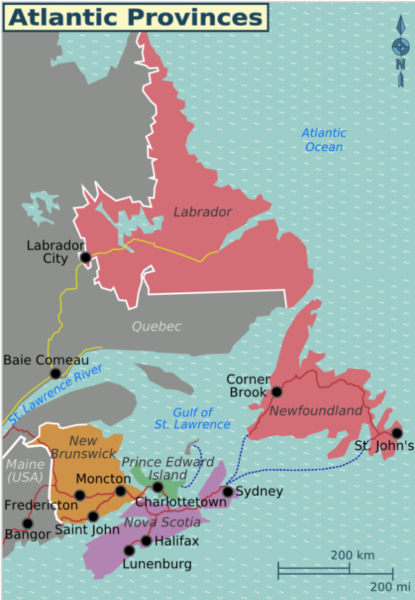
Even though institutions are currently in the process of collecting and returning data for the 2019 survey of online learning in Canadian post-secondary institutions, we (the Canadian Digital Learning Research Association) are still working through some of the 2018 data.
The regional report on Québec and francophone institutions will be posted shortly, but in the meantime the report on the Atlantic provinces is now up on the survey website. Here is a brief summary of the main findings. (I will report only on the main differences with the rest of Canada. The full national report is available here.)
Our definition of Atlantic Canada
This sub-report provides the results of the 2018 Canadian National Survey of Online and Distance Education, focusing on public post-secondary institutions in:
- Newfoundland and Labrador,
- Prince Edward Island,
- Nova Scotia, and
- New Brunswick.
Although Québec and Nunavut have Atlantic coastlines, the CDLRA included Nunavut in the grouping of institutions north of 56 degrees, and created a separate sub-report specific to institutions in Québec and francophone institutions.
The Atlantic region is relatively small, in terms of the number of institutions, with 24 in total (14 universities and ten colleges). Although the response rate was similar between the Atlantic region and the rest of the country at 79% (19 out of 24 institutions), the actual number responding (19) is quite small, so a response from one or two institutions can have a large effect on the average for the region as a whole.
Main results
Online enrolments
Newfoundland and Labrador is the leading province in the Atlantic region, if not the country, in terms of the proportion of students taking fully online courses for credit, with over a third of all post-secondary students taking at least one online course. The two institutions in Newfoundland and Labrador provided 50% of all the students in the Atlantic region taking at least one online course.
In Newfoundland and Labrador, 19% of all credit course registrations are fully online compared with the national average of 8%.
Conversely, the other three Atlantic provinces are well below the national average in terms of the proportion of online credit course registrations:
- Nova Scotia (6%),
- Prince Edward Island (4%) and
- New Brunswick (3%).
Open educational resources
Institutions in Atlantic Canada were less likely to use open textbooks than in the rest of the country.
In Atlantic Canada less than half (39%) of post-secondary institutions are using open textbooks and an additional 22% of institutions are exploring their use, compared to just over half of institutions (55%) using open textbooks and 19% exploring their use in the rest of the country.
Strategies and plans
Although the proportion of institutions reporting that online learning was very or extremely important to their institution’s long-term strategic or academic plan was roughly the same in the Atlantic region as the rest of the country, the proportion of institutions reporting that they either had a plan or were developing one for e-learning was lower than in the rest of the country (52% compared with 68% nationally) and a relatively high proportion of Atlantic institutions reported that they did not have a plan but needed one (37%).
Reasons for implementing online learning
As with the rest of the country, increasing access was the main reason. However, the opportunity to access students from outside the regular catchment area was particularly important in Atlantic Canada (93% of institutions giving this reason compared with 61% in the rest of the country).
Barriers to online learning
The most ranked reason in Atlantic Canada – the additional faculty effort required to develop or deliver online courses – was similar to the national response, but in Atlantic Canada, a higher proportion of institutions (84%) ranked inadequate training/pedagogical knowledge available for faculty in online learning as a barrier compared to the rest of the country (73%).
The percentage of institutions that reported that students were at least as satisfied with online courses as with face-to-face courses was lower in the Atlantic region (47%) when compared to the overall response for Canada (61%).
Conclusions
Overall, the Atlantic region was fairly close to the national average on most issues, including the growth in online enrolments, the percentage of students taking online courses for credit, and the percentage of fully online course enrolments.
However, there are significant differences between the Atlantic provinces in online course enrolments, with Newfoundland and Labrador having a much higher percentage and the other provinces a significantly lower percentage than national average. We also found that the Atlantic region has significantly less activity in open educational resources and open textbooks than the rest of the country.
Although most institutions in the Atlantic provinces reported that online learning was important for their future, they were less likely to have a plan or to be developing one for e-learning. Further, a lack of training and pedagogical knowledge in online learning for faculty was even more pronounced in Atlantic Canada than in the rest of the country, as was lack of acceptance of online learning by faculty.
Apart from Newfoundland and Labrador, the other Atlantic provinces probably need to increase efforts if they are to keep up with the national average in online learning, especially given declining populations and the potential for online learning to increase enrolments from outside the region.









 Dr. Tony Bates is the author of eleven books in the field of online learning and distance education. He has provided consulting services specializing in training in the planning and management of online learning and distance education, working with over 40 organizations in 25 countries. Tony is a Research Associate with Contact North | Contact Nord, Ontario’s Distance Education & Training Network.
Dr. Tony Bates is the author of eleven books in the field of online learning and distance education. He has provided consulting services specializing in training in the planning and management of online learning and distance education, working with over 40 organizations in 25 countries. Tony is a Research Associate with Contact North | Contact Nord, Ontario’s Distance Education & Training Network.

